January 17 Scots book of days
1/17/18 12:41 PM
January 17 356 Antony of Egypt Hermit Abbot feast day. The feast days were important in dating legal documents, as most referred to the feast day when prepared. Scotland was predominantly Roman Catholic celebrating Saints and feast days until 1560, when it became predominantly Protestant with stronger Calvinist and Puritan teachings as represented by John Knox. Puritan teachings dropped Saints, relics and feasts.
1446 David Lindsay, 3rd Earl of Crawford died. Regent to James II of Scotland. Between rivals claimants to the post of Baillie of the Regality. Members of Clan Oliphant fought on the side of the Clan Ogilvy who were also supported by men from the Clan Seton, Clan Gordon and men from the Clan Forbes of Pitsligo. Their enemy was the Master of Crawford and his Clan Lindsey who advanced with over one thousand men. (Master was the term used for the eldest male line of a Lord or Peer, before taking the title after the holder died.) Crawford of drongan and Haining 1100 2Douglas2 Stewart2 Ruthven2 Kinchin2 Jared2 Simmons2 Choate2 David
His father, David Lindsay, 3rd Earl of Crawford, rode between the two armies in an attempt to call a truce. However, an ill-advised Ogilvie, thinking that this was the start of the Lindsay’s attack, threw his spear at the Earl, hitting him in the mouth and killing him instantly. So began the battle, which went in Clan Lindsay’s favour. Here fell Ogilvie of Inverquharty, Forbes of Pitsligo, Brucklay of Gartley, Gordon of Borrowfield, and Sir John Oliphant of Aberdalgie (father of Laurence, first Lord Oliphant), along with 500 or so Ogilvis. Forbes. Crest: A stag’s head attired with ten tines Proper. Motto: GRACE ME GUIDE. Badge: broom Chief: Nigel Ivan Forbes, 23rd Lord Forbes Seat: Castle Forbes, Aberdeenshire. Crawford – Arkansas, Georgia, Illinois, Indiana, Iowa, Kansas, Michigan, Missouri, Ohio, Pennsylvania, Wisconsin,
1485 Louis II of Orléans, the cousin of the king (and future Louis XII of France) tried to invest Paris, but failed. He managed to escape on February 3 to Alençon, and made amende honorable on March 12. Royal troops placed around Évreux prevented him from joining Brittany, and he was locked up in Orléans. At the same time, the roused Breton nobility was brought back to order by the royal troops.
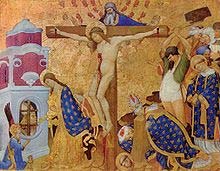 Last Communion and Martyrdom of Saint Denis, by Henri Bellechose, 1416, which shows the martyrdom of both Denis and his companions in Montmartre, Paris, France, circa 250 to 270 Last Communion and Martyrdom of Saint Denis, by Henri Bellechose, 1416, which shows the martyrdom of both Denis and his companions in Montmartre, Paris, France, circa 250 to 270 |
1586 Edinburgh plague continued in winter taking 24 in a single night. ‘ the haill people, whilk was able to flee,’ fled out of the town, nevertheless there died of people which were not able to flee,1400 and some odd. January. A History of Epidemics in Britain from A.D. 664 to the Extinction of Plague Charles Creighton, M.A. M.D. Demonstrator of Anatomy University of Cambridge. 1891
1599 never happened. (After December 31, 1599, Scotland began 1600 on January 1st) England would not change calendar until 1752, So December, the 10th month, made sense as the Latin ten, decem.
1648 – England’s Long Parliament passes the Vote of No Addresses, breaking off negotiations with King Charles I and thereby setting the scene for the second phase of the English Civil War.
1686 – Archibald Bower, born, Scottish historian (d. 1766). Educated at the Scots College, Douai, Bower became a Jesuit in Rome. He joined the Church of England a while after returning to London in 1726. Bower wrote a History of the Popes (1748–66, 7 volumes) and contributed to Universal History. Bookseller Andrew Millar 6th (clan Stewart, Lockhart, Hunter).
 |
A Universal history, from theearliest account of time. Compiled from original authors; and illustrated with maps, cuts, notes, &c. With a general index to the whole. Etc. London printed for S. Richardson,
- Osborne, C. Hitch, A. Millar, John Rivington, S. Crowder, P. Davey and B. Law, T. Longman, and C. Ware, MDCCLIX
1746 (in Scotland) 1745 in England. During the Second Jacobite Rising, the Battle of Falkirk (1746), 10 miles from Stirling. Muir was the last noteworthy Jacobite success. The second Battle of Falkirk took place on the 17 January 1746 (1746 in Scotland) between the Jacobites, under Bonnie Prince Charlie, and a government army commanded by Lieutenant General Henry Hawley. Hawley was defeated.
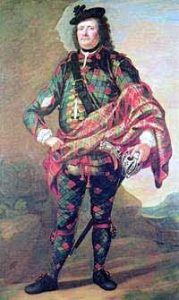 |
 |
Highland officers.
Hawley led his army out of Edinburgh to relieve Blakeney and arrived at Falkirk for the final approach. On 17th January 1746 the rebels (London’s term) were seen marching onto Falkirk Moor to the south west of the town. Hawley ordered the army to march onto the moor. The weather had broken and it was raining hard. It was also nearly dark.
Hawley had formed the view in the 1715 Jacobite rising that the highlanders would not stand against cavalry. The royal army formed facing the highlandrs on the moor with the three regiments of dragoons. The artillery was stuck in the mud at the bottom of the hill. Hawley ordered his dragoons to charge. The dragoons approached the highlanders and received a volley which caused them to break and flee down the hill back to Falkirk. Most of the royal regiments fled, The highlanders had become considerably dispersed and many of them were in doubt as to who had won the battle, which had lasted around 20 minutes. It was said that Cope made !10,000 in a wager that his successor would be beaten by the Highlanders as he had been.
Hawley was a protégé of the Duke of Cumberland. Horace Walpole said Hawley was illiterate, was a brutal disciplinarian and had the nickname ‘Hangman’ Hawley. As had Cope, Hawley neglected to ensure that he had a proper train of artillery. His army were mostly veteran regiments of foot from the Flanders war.
Hawley hanged all the deserters from the army he could lay his hands on. Captain Cunningham the artillery officer was tried by court martial and thrown out of the army after a ceremony of “degradation”. Thus disgraced, I don’t have further information as to his whereabouts, but perhaps he removed himself ‘across the sea’ to the North American colonies. Cunningham of Caprington 1162 2Stewart2 Miller2 Simmons2 Choate Isaac Scott
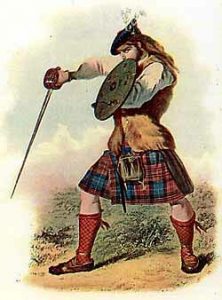 |
Highlander.
http://www.britishbattles.com/battle_of_falkirk.htm
Two battles, at Prestonpans 1745 and Falkirk 1746 (Scots calendar), so threatened the London Government that all British regiments were withdrawn from the Continent, even in the middle of the War of the Austrian Succession (or French and indian war in the colonies). So was the second Jacobite uprising in 3 decades. And after the crisis ended at Culloden 1746,
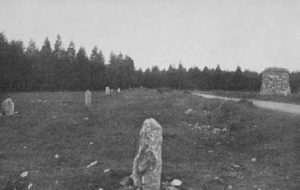 |
BATTLEFIELD OF CULLODEN. The Spell of Scotland by Keith Clark, 1916 to the Lord Marischall, Boston The Page Company. P.232.
Falkirk and Prestonpans seemed insignificant in hindsite. You’ve probably never even heard of Falkirk and Prestonpans. Nevertheless, the policy was resolved in London to depopulate Scotland, destroy the economy, destroy the food supply, ban the clans, ban tartans, and eliminate the threat for all time. Thus thousands more left or fled for the colonies. So many, that 3 decades later, a third of the signers of the Unanimous Declaration of Independence were born Scots or had Scots ancestry. Never to return.
Having been joined by an the reinforcements expected, and not yet attacked by Hawley, the Prince with the army marched to Falkirk, leaving 1200 men under the Duke of Perth to proceed with the siege of Stirling Castle. In the evening met the enemy and defeated them at THE BATTLE OF FALKIRK. The Government troops retired to Edinburgh, the Prince lodged in Falkirk in Mr. Menzies’s house. (pronounced ‘Mingis’)
 |
Muir Motto: DURUM PATIENTIA FRANGO,
 |
Crest; Bearded head with laurel garland crown.
1751 did not occur in England, Ireland, British North America, and British colonies, as 1751 only had 282 days due to the Calendar Act of 1750. 1751 ran from March 25th 1751 (Lady Day) to December 31st 1751, the next date being January 1st, 1752. But this date in 1751 did occur in Scotland and most European countries.
1761 – James Hall, born, Scottish geologist (d. 1832)
1773 – Captain James Cook and his crew become the first Europeans to sail below the Antarctic Circle. FRS, RN (born 7 November 1728– 14 February 1779)
 |
James Cook, portrait by Nathaniel Dance, c.!1775,
National Maritime Museum, Greenwich. Cook was the second of eight children of James Cook, a Scottish farm labourer from Ednam near Kelso, and his locally born wife, Grace Pace, from Thornaby-on-Tees.
1781 Battle of Cowpens , South Carolina. British Regiments – battalion of 71st Fraser’s Highlanders (disbanded after the war). The reserve comprised the 71st Highlanders and the cavalry of Tarleton’s legion. As the British foot attacked, the 71st Highlanders extended the line to the left, outflanking the Americans. The American line withdrew in good order. The British line, apparently sniffing a route, lost its cohesion as it hurried to pursue the Americans. The Americans halted and gave fire before Washington’s (American) dragoons again attacked, this time in the rear of the British line. The double envelopment. JANE Miller (nee PICKENS) Mrs. Robert Miller (the 3rd, Robert was born Ayr Scotland, clans Stewart, Hunter, Lockhart, Cochrane, Meldrum) [Jane’s brother, then Colonel (later Major General) Andrew Pickens, fought at Cowpens, American victory, featured in Sweet Liberty movie. Cowpens lead to (British) Cornwallis chasing (American) Morgan’s retreat for 400 miles over 6 weeks. Failing that, Cornwallis’ moved his army to Yorktown, Virginia in the summer of 1781, being trapped in the Tidewater of the Chesapeake. Next came the American Victory at Yorktown. War of Independence. Continental troops under Brigadier General Daniel Morgan defeat British forces under Lieutenant Colonel Banastre Tarleton at the battle in South Carolina. The Tarleton family was from Lancashire, and
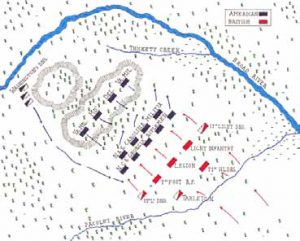 |
Battle of Cowpens ‘71st HLDRS’ (Highlanders) reserve in rear of British line. Classic DOUBLE ENVELOPMENT by the Americans against the attacking British. Wikipedia. After the main engagement got underway, and things went favourably for the British, as they optimistically so supposed, save for actions of the cavalry on the left, Lieutenant Colonel Tarleton, believing victory was at hand, signalled for the reserve. [Fraser’s Highlanders] The 71st Regiment and some of his Legion were ordered to strike and envelop the American right. Poor positioning of the regiment prior to the battle came into play dramatically delayed the [Fraser’s Highlanders] , and as they struggled forward, the American line of battle fired a deadly volley at 30 to 40 paces with devastating effect on the British line. An American charge resulted in a fierce melee [hand to hand sword and bayonette combat, with forces mixed randomly]. Major Archibald McArthur, supported by his pipers, rallied the [Fraser’s Highlanders] , who stood unflinching in musket fire for 10 to 15 minutes. Lieutenant Colonel Tarleton’s Legion abandoned the regiment’s left flank and most of the Fusiliers threw down their guns and surrendered, with only the [Fraser’s Highlanders] Regiment holding against the encircling Americans, the Georgian Militia charged unsuccessfully against the Regimental Colour. Unsupported and surrounded [Fraser’s Highlanders] begin to retire, and some even attempted to flee the field. American regulars and militia encircled the regiment by this time, and American Colonel Howard offered Major McArthur quarter [stop the slaughter immediately], the latter accepting his offer [surrender]. The detachment of [Fraser’s Highlanders] men left guarding the baggage train destroyed it and fell back behind the fleeing British cavalry, becoming the only [Fraser’s Highlanders] men of the 1st Battalion to escape capture. As a result of the defeat at Cowpens, [Fraser’s Highlanders] wore no facings on their uniforms for the rest of the war. Additionally, the surviving officers of [Fraser’s Highlanders] petitioned Lord Cornwallis, asking that the Regiment never serve under Lieutenant Colonel Tarleton again; a request that was approved. At the same time, the [Fraser’s Highlanders] was consolidated into a Brigade with the 23rd (Royal Welsh Fusilers) Regiment of Foot and the 33d Regiment of Foot. The fate of the Highlanders went continually downhill after Cowpens.
1883– Sir Compton Mackenzie, Scottish novelist (d. 1972).
 |
Mackenzie Crest: A mount in flames Proper. Motto: LUCEO NON URO. [from Latin: “I shine not burn”]. Badge: variegated holly or deer’s grass (heath club rush) Chief: John Ruaridh Grant MacKenzie, 5th Earl of Cromartie Seat: Castle Leod, Ross-shire.
1885 – A British force defeats a large Dervish army at the Battle of Abu Klea in the Sudan. Coldstream and Scots Guards. 2nd Dragoons (Royal Scots Greys),
The Battle of Abu Klea by William Barnes Wollen. The Battle of Abu Klea took place between the dates of 16 and 18 January 1885, at Abu Klea, Sudan, between the British Desert Column and Mahdist forces encamped near Abu Klea. The Desert Column, a force of approximately 1,400 soldiers, started from Korti, Sudan on 30 December 1884; the Desert Column’s mission, in a joint effort titled “The Gordon Relief Expedition”, was to march across the desert to the aid of General Charles George Gordon at Khartoum, Sudan, who was besieged there by Mahdist forces. The British forces consisted of the 1,100 British of the Desert Column under Sir Herbert Stewart, against a Sudanese force of approximately 12,000 fighters.
 |
Officer and soldier of the Coldstream Guards serving with the Guards Regiment of the Camel Corps in the Sudan in 1885. Picture by Orlando Norie. The Guards regiment of the camel corps was formed from the Grenadier, Coldstream and Scots Guards (with the Royal Marine Light Infantry) and the Mounted Infantry regiment from line infantry regiments. The Camel Corps caused enormous interest and comment in Britain. It was referred to as the ‘Nile Circus’. Lord Wolseley fuelled the mirth by ordering 1,000 white umbrellas to keep the desert sun off the corps. The regimental march selected for the corps was the Scottish air ‘The Campbells are coming’. This was transposed to ‘The Camels are coming’. http://www.britishbattles.com/egypt-1882/abu-klea.htm
1926 – Moira Shearer, born, Scottish actress (d. 2006). 1934 – Donald Cammell, born, Scottish film director (d. 1996) 1934 – Stuart Nisbet, born, American actor.
1981 Battle of Cowpens bi centennial.
 |
1986 thousands of elementary school class teachers are adjusting television monitors for a lesson from outer space to be taught and hosted by Space Shuttle Challenger’s crew, including perky Sharon Christa McAuliffe (1948) for NASA’s Teacher in Space Project (son Scot); and Ronald Ervin McNair, Ph.D. (1950). The crew continued its countdown preparations, including isolation to minimize chances of exposure to colds or ambient viruses.
1992 Flag of Russian Navy “#$%%#-&#'()#* +,#-.#((// Voyenno-morskoy flot Rossii. The flag of Scotland features St Andrew’s saltire cross. 
Naval Ensign. The regular Russian Navy was originally established by Peter the Great (Peter I) in October of 1696. Ascribed to Peter I is the oft quoted statement: “A ruler that has but an army has one hand, but he who has a navy has both.” The symbols of the Russian Navy, the St. Andrew’s flag and ensign (above), and most of its traditions were established personally by Peter.
 |
Russian Navy Jack
2012 Researching Family History: The story of Edward Francis Blair, who was a merchant mariner and temple builder. Published this date by the Deseret News. Edward was born in Montrose, Angus, Scotland, on Dec. 6, 1824 and was an apprentice seaman at age 14, in the Merchant Marines. Edward was married on Aug. 10, 1848, to Jane Fenwick of Newcastle-upon-Tyne. His father’s name was also Edward Blayr. Edward was baptized by Thomas Michael Wallace on Jan. 23, 1854, into The Church of Jesus Christ of Latter-day Saints. Edward took his wife Jane with their three children and left for America on a ship named the Thornton and left Liverpool, arriving in New York on June 15, 1856. After living in New York, Edward moved his small family into Tom’s River area of Somerset County, N.J., where there was a Mormon congregation, and secured a job as a fisherman. In 1860, the family came to Florence, Nebraska, and joined the wagon train of Capt. Jesse Murphy to journey to Salt Lake City, arriving on Aug. 30. In the Salt Lake Valley, Edward was a carpenter and stone mason on the Salt Lake Temple. Edward had charge of the large booms on the derrick, by which the huge cut granite was hoisted into place. This was the same principle by which cargo was placed on board ships. He had mastered an ability with heights through his years in the Merchant Marines.
http://www.deseretnews.com/article/705397349/The-story-of-EdwardFrancis-Blair-who-was-a-merchant-mariner-and-temple-builder.html?pg=all
2016 London. The British House of Commons debates a motion to ban Donald John Trump, Sr. (clans MacQueen, Macaulay, MacLeod, of Aberdeenshire and Outer Hebrides), (born June 14, 1946). His mother was Mary Anne MacLeod, (born May 10, 1912,– died August 7, 2000), who was married in 1936. Mary Anne was born at Tong, Stornoway, on the Isle of
Lewis, off the coast of Scotland, United Kingdom. At age 18, in 1930, Mary visited the United States, met Fred Trump and they were married in 1936.
www.express.co.uk
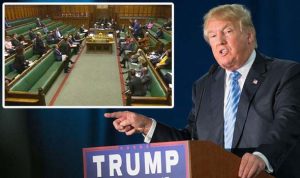 |
Who knew on such a slow news day the House of Commons had three extra hours to debate a single travel ban for a celebrity son of Scotland? Seems the lessons of the Scottish and Highland Clearances (1748-1820) are unknown (to wit – run off 95% of the Scots and wonder why they don’t come back, after all is forgiven?) London should apologize to the Scots descendants. Oh wait – they did us a favor.
2017 Utah is ranked 2nd highest (4.6% of the state population) among the 50 United States with the top percentages of Scottish residents (Wikipedia 26 March 2017
https://en.wikipedia.org/wiki/Scottish_Americans#Scottish_Americans_by_s tate ). How are the Scots in Utah doing? Sutherland Institute and the American Conservative Union Foundation found Utah ranks first in the nation for family prosperity from the Family Prosperity Index (FPI), which calculates economic and social factors that are indicative of family prosperity. Jan 17, 2017
https://www.ksl.com/?sid=42845734&nid=148
Disclaimer:
Utah Standard News depends on the support of readers like you.
Good Journalism requires time, expertise, passion and money. We know you appreciate the coverage here. Please help us to continue as an alternative news website by becoming a subscriber or making a donation. To learn more about our subscription options or make a donation, click here.
To Advertise on UtahStandardNews.com, please contact us at: ed@utahstandardnews.com.


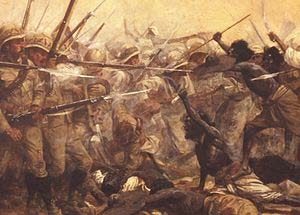
Comments - No Responses to “January 17 Scots book of days”
Sure is empty down here...